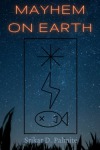Volume 7 Bonus Content

Advertisements
X
Reading Options
Font Size
A-
15px
A+
Width
Reset
X
Table of Contents
Loading... please wait.
Volume 7 Bonus Content:
No side story this time. Sorry, folks.
General Information:
This section contains information not related to the story, such as fun facts about things mentioned in the story—like an appendix.
Magnets:
- A magnetic field is produced around an atom due to a change in its charge distribution. When many atoms are together and aligned in the same direction, the ‘magnetic moments’ add up and the whole material is resultingly magnetic.
- Diamagnetism is the property of a material’s atoms to align themselves such that they together create a magnetic field to oppose one that is currently acting on them. Paramagnetism is somewhat similar, except the result is that the atoms align to strengthen the existing magnetic field and the effect lasts until the next magnetization. Ferromagnetism is similar to paramagnetism except the atomic alignment happens without a magnetic field, and the magnetism disappears past a certain temperature. An example of a ferromagnetic material is Iron (Ferrum).
- An electromagnet is an artificial magnet produced by running an electric current through a coil of wire surrounding a ferromagnetic ‘core’. This magnetizes the core as long as the current remains, past which the effect weakens over time. Requiring continuous power, these are generally used where permanent magnets wouldn’t: where one needs to change the amount of magnetic field or turn it off and on. It’s used everywhere from electric generators to motors.
- Superconducting electromagnets are stronger magnets that use a superconducting wire at low temperatures, which allows for more current flow and thus more magnetic field. Even stronger are Bitter electromagnets, which can be twice as strong as superconducting ones, and twenty times stronger than normal ones.
Electroshock weapons:
- Electroshock weapons use a high-voltage, low-current electric shock to paralyze victims with minimal injury. They are a good alternative to traditional weapons like guns, which are restricted in many countries, and can still provide self-defense capabilities.
- TASERs fire two thin wires into the target and pass a current between them.
- Stun guns require you to touch the target with two prongs with an electric arc between them.
- It attacks the nervous system and forces muscles to work quickly and inefficiently, instantly depleting blood sugar levels. The loss of energy coupled with the interruption of neurological impulses that direct muscle movement cause disorientation, pain, and paralysis for minutes, depending on how many seconds they were exposed to the discharge.
- An electric arc is caused by passing a current through the air, which produces glowing plasma.
Military strategies:
- Attrition warfare: A defensive strategy usually used against a superior opponent involving wearing them down over time. The principle behind it is that if your enemy loses resources at a faster rate than you, then you will eventually gain a favorable position, at which point you may switch to offensive strategies. Fabian strategy, named after the Roman Commander who used it against the warlord Hannibal, uses attrition and tries to avoid frontal attacks.
- Siege warfare: Slow, low-intensity warfare that involves surrounding an opponent, who may be in a defensive formation, and, rather than directly attacking, waiting for them to run out of resources before either attacking or allowing them to surrender. This avoids casualties while still ensuring victory.
- https://en.wikipedia.org/wiki/List_of_military_strategies_and_concepts
Groupthink:
- According to Encyclopedia Britannica “Individual members of… groups tend to accept a viewpoint or conclusion that represents a perceived group consensus, whether or not the group members believe it to be valid, correct, or optimal. Groupthink reduces the efficiency of collective problem solving within such groups… Decision making… neglects possible alternatives and focuses on a narrow number of goals, ignoring the risks… It fails to seek out alternative information and is biased in its consideration of that which is available”
- The eight symptoms are:
- An illusion that the group is invulnerable
- Not questioning the morality of the group
- Rationalizing (or ignoring) any arguments against the group’s beliefs
- Creating negative stereotypes of outsiders
- ‘Mindguards’ who filter out negative information
- Censoring oneself from speaking out against the group’s beliefs
- The illusion of unanimity in the group and assuming non-opposition is acceptance.
- Pressure to conform and not be ‘disloyal’ to the group
- Used by cult leaders and politicians to gain a massive following. An example is described in the documentary ‘Wild Wild County’.
Glass & plexiglass:
- Glass is made by heating Soda ash (to reduce melting temperature), silica sand, and limestone into an amorphous solid.
- However, only certain sand can be used. Desert sand consists of tiny quartz (silica) grains that rub against other minerals and turn them into powder. In some deserts, the powder is blown away by the wind, leaving just the quartz. In others, gypsum and other materials remain. On beaches, sand contains many other minerals and sea salt. Purer sands can be used for glassmaking.
- The demand for sand for the glass and cement industries is so great now that it has recently given rise to the crime of sand theft.
- Plexiglass is a thermoplastic (plastics that are moldable at high temperatures) that is often used as a substitute for glass due to its transparent nature, flexibility, and shatter-resistance. Its material, Poly(methyl methacrylate) is also used in acrylic paint.
0


